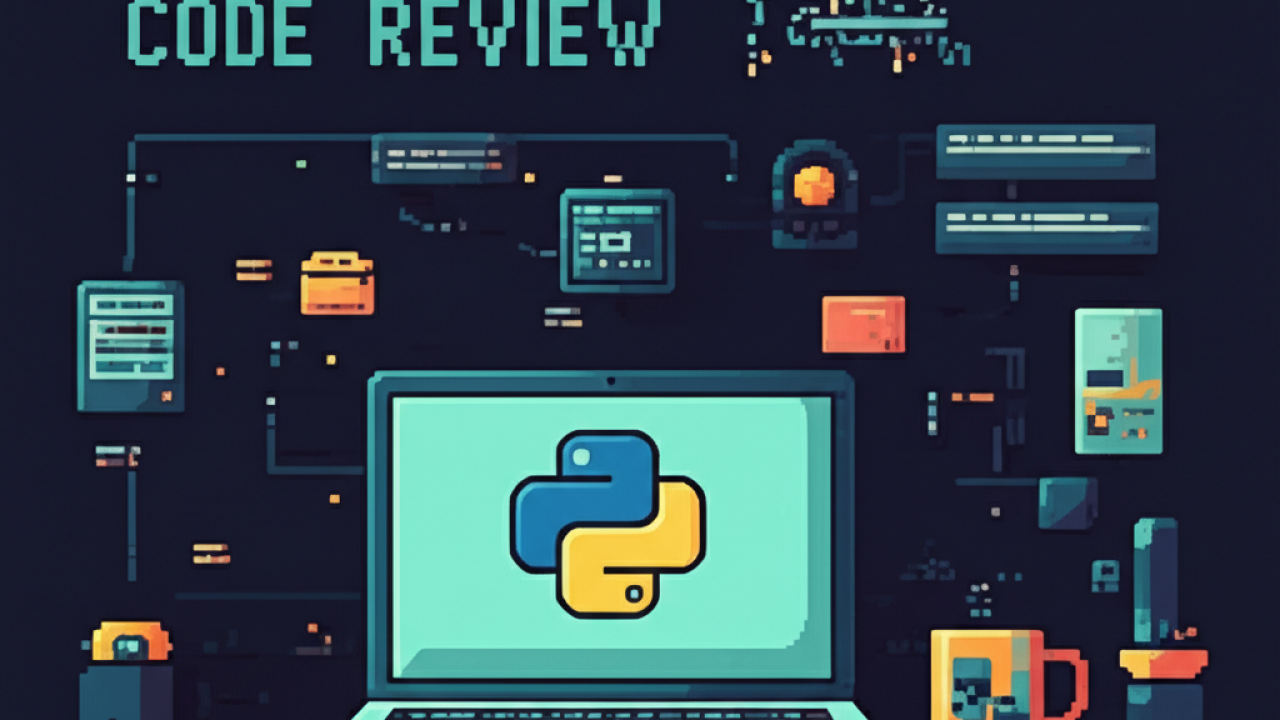Doing code review in Python goes way beyond just looking for obvious bugs. It’s one of the most important steps to make sure the code going to production is clean, safe, and easy to maintain.
In a team working with a dynamic language like Python, where the compiler won’t catch everything for you, code review becomes the last technical checkpoint before deploy. It’s where you catch questionable architecture decisions, readability issues, performance risks, and even security flaws that might have slipped through.
In this article, we’ll cover the main reasons to have a solid review process, some best practices, and a technical and straightforward checklist you can use for your next PRs.
Why Python Code Review is Not Optional
Having a solid code review process in Python isn’t just a formality. It’s what makes the difference between a messy codebase and a truly maintainable project. It’s not just about catching bugs—it’s about improving code quality, sharing context, and keeping the team aligned.
Why Python Code Review Matters 🐍
Reviewing Python code plays several critical roles in the development cycle:
Catching problems early
Review is the last filter before production. The earlier bugs appear, the cheaper (and less painful) they are to fix.
Improving overall code quality
Reviewers aren’t just looking for syntax errors. They suggest ways to make the code more readable, more efficient, and easier to maintain. Small tweaks today avoid big refactors tomorrow.
Spreading knowledge across the team
When devs review each other’s code, they learn about parts of the system they might never touch otherwise. It’s a natural way to spread context, patterns, and good practices.
Ensuring style and architecture consistency
Every dev has their own coding style, but the code needs to feel like it was written by the same team. Code review is the checkpoint for keeping things consistent.
Mentorship in practice
Reviews become a technical guidance opportunity. More experienced devs can point out better ways to solve a problem, highlight hidden risks, or suggest more modern patterns—all within the normal workflow.
Python Code Review Checklist
1. Pre-review (Author)
- Black formatted (
black .) and isort applied - Local tests passing (
pytest -q) - Clear PR description: why, what, and how to test
- Small diff (ideally up to 400 LOC) or PR split into logical commits
- Linked issue or reference ticket
2. Style & Formatting
- PEP 8 compliance and extra flake8 rules
- Lines ≤ 88 columns (Black standard)
- Imports organized with isort and no cycles
- Clear variable and function names, no cryptic abbreviations
- PEP 257 docstrings for modules, classes, and public methods
3. Code Quality & Readability
- Functions ≤ 40 lines and cyclomatic complexity < 10 (
radon cc -a) - No duplication detected by flake8-builtins or jscpd
- Simple conditional blocks: avoid deep if/elif/else nesting
- Proper use of list/dict/set comprehensions instead of verbose loops
- Avoid magic numbers: extract to named constants
4. Structure & Design
- Single Responsibility Principle for modules and classes
- Light
__init__; heavy logic moved elsewhere or into class methods - Well-separated layers (e.g., domain vs infrastructure)
- Use of dataclasses (
@dataclass) when the object is just a data container - Public interfaces remain backward compatible
5. Static Typing
- Full PEP 484 type annotations on public functions
- No
type: ignorewithout justification comments - No mypy errors (
dmypy run --) - Modern typing syntax (
|for union, Self, Literal, TypedDict) - Runtime type validation when exposed to external data
6. Security
- No eval, exec, unsafe pickle, or SQL string concatenation
- External inputs validated and sanitized (pydantic, marshmallow)
- Cryptography using maintained libs (cryptography, passlib)
- Dependencies clean in safety check or pip-audit
- Secrets kept out of code (env vars, Vault, AWS Secrets Manager)
7. Performance
- Proper data structures (set or dict for O(1) lookups when needed)
- Avoid unnecessary intermediate lists, prefer generators when possible
- Batched disk and network writes
- Heavy profiling code removed, no stray print or noisy logging.debug in hot paths
- Verified with pytest-benchmark if performance was part of the PR scope
8. Concurrency & Async
- Only one concurrency model per module (threads / async / multiprocess)
- asyncio with timeouts and async with for connections
- Documented and justified locks (
threading.Lock) - No mixed IO/CPU within the same event loop
- Resources properly closed (
await conn.close()or context managers)
9. Testability
- ≥ 80% coverage for new modules (
coverage run -m pytest) - Unit tests focus on logic; integration tests cover real dependencies
- Mocks only where side effects are irrelevant
- Failure cases (exceptions) covered
- Reusable fixtures with no hidden dependency on test execution order
10. Observability
- Structured logging (json, extra={}) with no PII
- Key metrics (latency, errors, queue length) exported via OpenTelemetry or prometheus_client
- Tracing propagating trace_id through the full call stack
- Alerts configured for SLO thresholds
- Debug logs disabled in production
11. Documentation
- README or docs/ updated with new behavior
- Comments only where code isn’t self-explanatory
- Usage examples in docstrings or doctest blocks
- Changelog updated if it affects public version
- Mermaid diagrams for complex flows when helpful
12. Dependencies & Packaging
- pyproject.toml defines runtime and dev requirements separately
- Versions pinned via poetry lock or pip-tools
- No obsolete or abandoned dependencies
- License compliant (check with licensecheck)
- Wheel builds and installs cleanly (
pip install -e .) with no warnings
13. Compatibility & Deploy
- Supports all declared Python versions (e.g., 3.9+ tested in CI)
- No absolute environment-dependent paths
- Configurable via env vars with safe default values
- Slim Docker image (
python:3.12-slim, multi-stage if build needed) - Idempotent and reversible migration scripts
Best Practices for a Python Code Review That Doesn’t Turn Into Bureaucracy
Doing Python code review is way more than just dropping an “LGTM” and moving on. It’s the time to really pay attention to technical quality, design decisions, and even readability of each change. The problem is, if not done right, the process turns into a bureaucratic checklist before merge, with no real impact on code quality.
This is about focusing on what really matters for a Python review that actually helps.
How to Give Technical Feedback Without Being That Annoying Reviewer
Focus on the code, not the person
Avoid anything that sounds like an attack. No “You messed this up”, “This is wrong”, etc.
Prefer:
“This section could cause errors if the input is None”
or
“Does it make sense to break this function? It’s getting hard to follow.”
Be direct, but give context
Don’t just say “This is confusing”. Explain exactly what’s wrong: “This loop is hard to follow because it mixes transformation and filtering logic. Maybe split it into two steps?”
Show the why, not just the what
Just pointing out the problem doesn’t help much.
Explain the impact: “This dict is being mutated inside a loop. Could cause weird side effects elsewhere if someone’s holding a reference.” Or: “Missing a context manager here. If an exception happens, the file stays open and could lock the system in production.”
Don’t be the ‘micro-nitpick’ guy on stuff CI already checks
If the project already uses Black, isort, flake8… don’t waste time pointing out whitespace or import order. Focus on what actually needs human review: design, performance, security, readability.
Give credit when it’s due
Saw an elegant solution? Say it.
“This defaultdict solution is really clean. Nice.”
Small technical praise, zero flattery.
How to Take Feedback Without Creating Unnecessary Drama
Detach your ego from the code
Everyone writes bad code sometimes. That’s fine. Better to fix it now than ship bugs to production later.
If you didn’t get the point, ask
“Can you explain the issue better?”
“Do you have an example of how you’d do it differently?”
Don’t treat feedback as orders
If you disagree, explain why.
“I think keeping it this way works better because of X and Y. Does that make sense?”
Iterate with intent
Don’t blindly accept everything. Understand the suggestions, assess the impact, adjust, or discuss.
Always say thanks
Nobody gets paid just for liking code review. A simple “Thanks for the review” goes a long way, especially in busy teams.
Making Code Review Part of the Team Culture (For Real)
Everyone reviews, not just seniors
Reviewing is a technical skill. The more people practice, the better the team gets.
If something keeps coming up, time to set a convention
If every PR turns into the same debate, pause and set a team rule.
Example: “From now on, all public functions need type hints.”
Document important decisions inside the PRs
If there was an important technical discussion, leave it documented in the PR for future reference.
Good feedback is the one that makes visible improvements to the code
If after 10 reviews the code still looks bad, something’s broken in the process.
And celebrate when the process works
When a review prevents a production bug or improves performance, call it out. It helps keep the team engaged.
Conclusion
Python code review isn’t just another step before merge. It’s one of the most effective ways to maintain code quality, prevent future problems, and make sure everyone on the team understands what’s being shipped.
The goal isn’t to chase the perfect solution or turn every PR into an endless debate. It’s about doing enough to ensure the code is clear, safe, testable, and consistent with the rest of the project.
With a simple process, a focused checklist, and a collaborative mindset, teams can review fast and well—without unnecessary bureaucracy and without letting preventable issues slip through.



